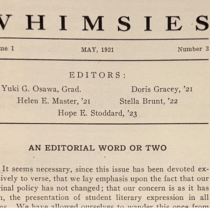Magazine

Writing in Secret
The Whimsies was an anonymously published literary magazine that became massively popular on U-M’s campus in the early 1920s. But who was behind it?
By Madeleine Bradford
The student literary magazine The Whimsies was inspired, at first, by indignation.
“Professions, athletics, and the social side of life,” got the bulk of attention and encouragement at U-M, leaving literature and the arts to suffer, according to a 1921 article in The Michigan Daily by Stella Brunt.
Being “frankly dissatisfied” with U-M’s lack of artistic encouragement, a small group of students started a new literary magazine in secret. By writing and assembling it themselves, they could distribute it anonymously.
The first two issues of The Whimsies were made on hand-cranked duplicating machines that churned out mimeographed copies. These imperfect pages, peppered with white space where ink should be, were clipped together, then “surreptitiously distributed” from Ann Arbor mailbox 147.
Ink-smudged and triumphant, the authors went home.
The publication was well received. “Box 147 has a real idea,” wrote “L.M.W.” in The Michigan Daily, praising the mystery publisher and using its mailbox number in place of a name. But who, exactly, was “he?”
Rumors swirled. One theory was that The Whimsies was being published by a member of the faculty. Encouraging letters began arriving, and writing submissions started coming in, but the publishers’ identities remained hidden—for a time.
The first 45 copies of inaugural issue had been mimeographed by hand but, by the third issue, the publishers were distributing 1,000 copies and had even found a printer: local bookstore owner George Wahr.
Then, on the front page of the third issue, the identity of the mastermind behind The Whimsies was revealed. “He proved to be five girls!” wrote Stella Brunt.
Stella should know; she was one of the five. The other contributors were Yuki Osawa, Doris Gracey, Helen Master, and Hope Stoddard.
Opinion pieces in The Michigan Daily had all speculated that the author was a “he.” None of them seemed to consider that the publisher was a woman—or multiple women.
The Whimsies quickly pivoted, vowing to have a more even distribution of men and women in charge of the literary magazine in the future, to avoid accusations of unfairness.
Soon, they also found a mentor: the poet Robert Frost.
Teaching in Ann Arbor for the 1921–1922 academic year, Frost became a guest critic for The Whimsies, offering them advice. In return, they “respectfully and affectionately” dedicated the first issue of Volume 2 to him.
The Whimsies was later folded into another student publication, The Inlander, which lasted until 1930. Its founders’ belief that “there was among the students an urge for artistic expression as well as love for art itself” has proven true. Today, student literary publications on campus include Xylem Magazine and the Fortnight Literary Press.
You can find copies of The Whimsies in the Bentley’s Inlander publications.
